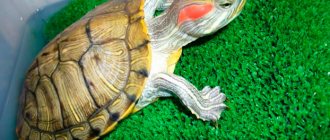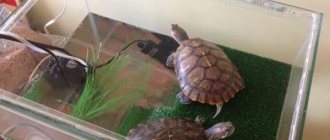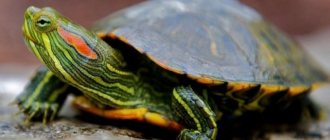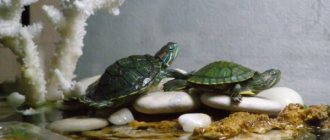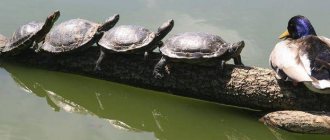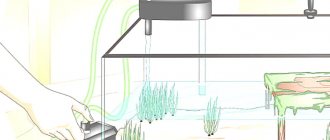To ensure that the purchased exotic reptiles grow healthy and develop well, you should find out what to feed the red-eared slider and how to diversify the diet before purchasing it. It is better to stock up in advance on those products, plants and dry food that are needed.
What do you feed red-eared turtles at home?
Despite the fact that red-eared turtles are unpretentious eaters and are omnivorous creatures, the basis of reptile nutrition should be food high in protein.
An approximate diet for a red-eared slider includes the following components:
- Meat and animal by-products.
- Various types of fresh fish and seafood, dried factory feed.
- Plant foods – greens, fruits and vegetables.
- Insects.
- Mushrooms.
In addition to this list of products, additional nutrition in the form of vitamins and minerals is necessary for the healthy development of the turtle. This is especially true at the stage of growing up of an individual, whose growing body needs microelements. If your pet regularly eats fresh meat, fish and vegetables, taking vitamins is not necessary. However, some owners, trying to save on keeping their pet, feed the turtle exclusively with semi-finished products, which have very dubious benefits. In this case, a course of vitamins is vital.
Turtle eats cabbage
It is important to remember that the diet of turtles largely depends on their age. Young individuals under one year of age take the necessary elements for the development of the body in products of animal origin. It is recommended to feed an adult turtle more varied, adding plant foods to the diet.
Meat
When purchasing an aquatic turtle, the owner of the reptile should be prepared to spend money on healthy food for the pet. The diet should include meat and offal as the main source of protein and vitamin A. Turtles like to eat the following types of meat:
- rabbit meat;
- lean poultry;
- beef.
Fatty pork and lamb are contraindicated for turtles. Meat is occasionally given raw, but more often the product must be boiled so that pathogenic bacteria do not enter the animal’s body. Regular consumption of raw meat can lead to the development of rickets.
In addition to small pieces of boiled beef or poultry, red-eared turtles happily eat offal such as liver and heart. Food is easily digested and has a beneficial effect on the health of the individual’s skin. In some cases, large turtles may eat a small mouse.
What fish to feed red-eared turtles
One of the most important components of a healthy turtle diet is sea and river fish. Any low-fat variety will do, the main thing is to process the fillet correctly. The food should be completely free of bones and offal. Experts advise pre-holding the fish in hot water to rid the product of harmful substances.
Red-eared turtles love to hunt for small fish. They happily eat guppies, crucian carp, swordtails and other inhabitants of home aquariums. A real delicacy for these reptiles is seafood, which does not require pre-processing and is served raw. A cocktail for a red-eared reptile may consist of the following ingredients:
- green shrimp;
- shellfish;
- squid pieces;
- octopus meat;
- snails and much more.
Plant food
In order to properly maintain reptiles, it is worth including in the menu not only animal food, but also plant food mixtures. Plants can be fed to young and adult individuals, and with age the amount of this food should increase.
When keeping a turtle in an aquarium, the menu must include the following herbal components:
- Various types of grass. Amphibians should be fed plantain, clover, leaves and flowers from dandelions, and rhubarb. Turtles are especially fond of coltsfoot leaves, sprouted grains of oats and barley;
- Reptiles will happily eat plums, banana pulp, pear slices, juicy pitted peaches, mangoes; it is advisable to cut all these fruits into small pieces. You can also give orange, tangerine, pieces of melon pulp;
- Freshwater animals can eat aquarium vegetation. In the aquarium you can plant duckweed, spirogyra, water beetle, and pond algae;
- Vegetables must be included in the menu. The most favorite vegetables include bell peppers, cucumbers, tomatoes, eggplants, zucchini, pumpkin, radishes, celery, legumes, carrot roots, and beets. But white cabbage and other varieties of this vegetable should not be given;
- Once every 7 days, the turtle can be given pieces of mushrooms such as boletus, champignons, and russula.
Important! Is it possible to give reptiles food from the human table (bread, cheese, cottage cheese, sausage, cereals and others)? In no case, it can negatively affect the functioning of the digestive system. Also avoid feeding pet food, citrus peels, and berries with seeds.
How often to feed your red-eared turtle
The frequency of feeding a turtle depends on several factors, the main of which are the animal and its individual characteristics. Thus, feeding adult red-eared turtles will take a minimal amount of time from their owners. The older the reptile gets, the less often it is fed. For some individuals, one serving per week is enough. However, there are some nuances.
If your pet's diet preferably consists of plant-based foods, the frequency of feeding increases. Meat and fish need more time to digest, and animal food saturates the turtle’s body for a long time. However, you should arrange the flora of the aquarium so that your pet can snack on algae if desired.
How many times a day should you feed your red-eared slider?
A turtle of any age only needs one portion of food per day. Very young individuals are fed daily, eventually increasing the period of abstinence to a week.
Turtle eats meat
Feeding with artificial feed
This is the best choice for busy people who do not have time to prepare a diet for a turtle or cut up food. Pet stores have special balanced food for red-eared turtles in tablets, granules, flakes and capsules. In fact, they are food for fish, but improved taking into account the needs of the reptile's body.
There are times when a turtle does not like the pungent smell of such food; it turns away from artificial food, but after a while it still gets used to it. Its main disadvantage is the high price.
What to feed baby red-eared turtles
What a little turtle eats determines its future health. The diet of young animals must include seafood. It is useful for armored babies to hunt aquarium fish. Turtles can be given clams and pieces of shrimp, but the food is always served raw. You cannot feed small red-eared turtles with products of plant origin - such food will not bring the desired benefits.
The first year of life of red-eared reptiles is very important for the formation of the skeleton and strong shell. For the healthy development of the body, babies need calcium and vitamin A, which is aimed at renewing skin cells and creating keratinized tissue. The turtles are fed daily, adding bone meal to the portions. In addition to fresh fish, you can purchase combined dry food for young animals at a pet store, after consulting with the seller.
Is it necessary to include mineral and vitamin supplements?
Additional fortified supplements are required for young individuals in whom the formation of the bone skeleton, strengthening and construction of the shell occurs. It is during this period that they require increased levels of calcium.
So what supplements should be included in the reptile menu:
- Every day you should add ground bone meal to your food. A pinch is enough for small turtles, but for adults it is recommended to add 1 teaspoon to the aquarium every 7 days;
- You can mix special vitamins into the food. Dosages are usually indicated in the instructions;
- You can include fortified feed mixtures in the menu.
What should you not feed your red-eared turtle?
Despite the fact that this armored reptile is considered an omnivore, there is a certain list of foods that are strictly contraindicated for these animals. The list of foods harmful to turtles includes the following components:
- poisonous land plants and algae (Elodia, Ambulia, Legendandra);
- plant and animal products containing large amounts of oscalates, phosphorus, purines (tomatoes, cabbage, raw liver, fatty meat, etc.);
- poisonous and poisonous insects;
- locusts and grasshoppers with serrated stalks;
- fatty meat and fish;
- bread, potatoes, etc.
Many of the above foods contain substances that can lead to the development of diseases such as gout, goiter and iodine deficiency in the turtle. The seemingly beneficial phosphorus interferes with the absorption of calcium, which also applies to oscalates.
Suitable varieties
The main food for red-eared turtles is fresh, low-fat fish, mainly small river fish. Factory-made food, as well as meat and bloodworms, cannot provide the correct ratio of elements for the development of a pet and should be given only in addition to the main diet. But not all fish will be useful for the red-eared turtle; it is recommended to choose the following varieties:
Regular consumption of fish will protect your pet from rickets and vitamin imbalance; small turtles (up to 2 years old) need to be fed this way daily. Many manufacturers offer turtle food based on dried fish. This option is suitable for supplementary feeding or in case of departure of the owners, but cannot provide the correct diet. Also, if you constantly buy granulated food, the turtle may become weaned from fresh food and refuse to eat.
How to properly feed a red-eared turtle
Even knowing the exact list of what red-eared sliders eat or don’t eat, you can make a number of dangerous mistakes. The most common disease of armored reptiles is common overeating. The owner of the animal needs to develop a strict feeding schedule for the pet in order not to succumb to the provocations of the cunning little face that is just begging. However, if it is obvious that the turtle is hungry, it must be fed.
The turtle feeder should not be overcrowded; too much food can also lead to overeating. Having fed the pet to its fullest, after a while the owner notices that the animal has become lethargic and passive. In this case, you should contact your veterinarian. If you still think that the reptile does not have enough food, it is better to give preference to algae and other products of plant origin. The health and longevity of a turtle directly depends on how much food the pet regularly consumes.
It is important to know how to feed a turtle in such a way that its body receives all the necessary substances. In addition to a varied, complete diet, owners of armored pets should not forget about vitamins. To make the creature's skeleton and shell stronger, it is worth feeding your pet with bone meal once a week.
If, however, the red-eared turtle stops eating, you should look for the cause and begin treatment.
Caring for your turtle
The first thing you should pay attention to when purchasing a pet is its appearance and size. A turtle that is under 5 cm in size at the time of purchase will be very difficult to raise. At this age, small individuals are susceptible to various infections and diseases.
This is how natural selection takes place. Therefore, a turtle 5–7 cm in size will be the best choice when purchasing
At this age, small individuals are susceptible to various infections and diseases. This is how natural selection takes place. Therefore, a turtle 5–7 cm in size will be the best choice when purchasing.
You should also carefully examine the color of the shell. The claws and tail must be intact. The skin looks healthy and the eyes shine. After the pet is in the aquarium, watch how it swims. A healthy turtle should swim smoothly, without leaning in different directions.
Healthy turtle
Features of treatment
After purchasing a pet and moving it into an aquarium, it may go through an adaptation period. Typically it will take 2 to 5 days. At this time, the animal becomes a little inhibited, or, conversely, very active. There is no need to panic and pick up the animal. Give him peace and time to adapt to new conditions. After a while, the turtle will get used to the new environment and become calmer.
When trying to pick up a turtle, do it very carefully and always with both hands. Not all representatives are willing to make contact. Some may flounder, hiss, and defecate in fear. The shell becomes slippery in water; keep this fact in mind when removing your pet from the aquarium.
After you hold the turtle in your hands, be sure to wash them with soap. Despite being kept clean, turtles are often carriers of salmonellosis. To avoid the spread of infection, you must always monitor the condition of the aquarium and the quality of the food.
Cleaning the shell
Since green algae in an aquarium is a source of infection, it is important to regularly clean not only the container, but also the turtle’s shell. They cannot do this themselves. During the decomposition process, algae also fall under the surface of the shell, and as they decompose, they harm the shell
During the decomposition process, algae also fall under the surface of the shell, and as they decompose, they harm the shell.
You will get used to the fact that once every 3-5 days you need to take the turtle out of the water and wipe its shell with a clean cloth, a special soft napkin, or gently brush it with a toothbrush. During the process, you should try to remove all small particles of algae and other dirt.
Cleaning the shell with a toothbrush
Some unscrupulous owners try to make the turtle's shell beautiful and lubricate it with various oils or creams to add shine. This is strictly prohibited, as it harms the skin and interferes with the healthy “breathing of the body” of the pet.
What can overfeeding cause?
Owners of red-eared reptiles often come to veterinarians complaining about the apathy of their aquatic pets. At the same time, the animal’s diet consists of natural products, and the diet is very varied. The problem is that animals eat too often or too heavily. Large portions of food often lead to disastrous consequences, one of which is digestive disorders.
When getting a red-eared creature, you need to think about the animal’s diet in advance. Despite the fact that turtles require a variety of food, their portions are negligibly small and pets eat very rarely. Even the laziest animal lover can have an adult turtle, which he will have to feed once a week. However, do not forget that the animal should not be overfed, nor should it be abused with dry food.
Previous
InhabitantsAbout the maintenance and care of a land turtle from A to Z
Next
Inhabitants Let's figure out what crayfish eat at home
Arrangement of the aquarium
The owner should worry about the turtle’s comfortable life at home in advance. This applies primarily to the arrangement of the home of an exotic beauty. To make a comfortable house for her, you need to purchase:
- Aquarium with a capacity of 150-200 liters.
- External or internal filter for water purification.
- Heating lamp.
- Ultraviolet lamp for aquatic turtles with UVB 10%.
- 100 W heater.
- Materials for arranging coastal or island space. Pet stores offer a completely finished island.
- Lamp and thermometer.
Often future owners prefer not to bother themselves with following all the recommendations. In addition, they know a little about the care and maintenance of the red-eared turtle. The result of such irresponsibility is often the illness or death of the pet.
Read more: aquarium for the red-eared turtle.
A red-eared turtle needs an aquarium with a capacity of 150-200 liters
Shore heating
Proper development of the coastal area is vital for the animal. Under natural conditions, turtles come out of the water to warm up.
Reaching an ambient temperature of +30–35 °C becomes possible thanks to a special lamp, which should be located close to the animal. But it should be borne in mind that too close a heat source can cause burns.
The lamp must be insulated from water. The turtle will definitely dive, and splashes on the base can lead to damage to the device. For this reason, the luminaire should be completely isolated from fumes and splashes. The duration of its operation during the day should be 10-12 hours.
UV lamp
To properly care for a red-eared slider at home, you must have an ultraviolet lamp that ensures stable absorption of calcium and B vitamins. This process is necessary for the proper development of the pet’s shell. If the absorption of necessary substances is impaired, the animal may develop rickets, which will lead to the curvature of its shell.
The lamp should be placed directly above the turtle so that the walls of the aquarium do not block the penetration of ultraviolet rays. The operating time of the device should be about twelve hours daily.
An ultraviolet lamp will ensure stable absorption of calcium and B vitamins
Water requirements
To keep a red-eared turtle at home, you should pay special attention to the purity of the water. Exotic reptiles spend most of their time in it: they sleep, eat, and relieve their natural needs. Dirty water can become a source of disease and infection
In addition, it gives off a specific smell in the apartment. Once or twice a week you should partially change the water. Its complete replacement is carried out once a month with mandatory thorough cleaning of the walls. In this case, it is necessary to remove the entire contents of the aquarium, and transfer the turtle to a container filled with water.
Dirty water can become a source of disease and infection. In addition, it gives off a specific smell in the apartment. Once or twice a week you should partially change the water. Its complete replacement is carried out once a month with mandatory thorough cleaning of the walls. In this case, it is necessary to remove the entire contents of the aquarium and transfer the turtle to a container filled with water.
Dirty water in an aquarium can become a source of disease and infection in red-eared sliders.
This process can be simplified by installing filtration devices. The internal filter is not powerful enough, so the water will still have to be changed, albeit not so often. An external filter will perfectly solve the cleaning problem, but it is not suitable for everyone due to the high price.
The water temperature in the aquarium should be 22-28 °C. You need to measure it using a thermometer. If the temperature drops, the water should be heated using a heater. Before adding water to the aquarium, it should be allowed to sit for one to five days. Thanks to this, it will be cleared of chlorine and other harmful compounds.
